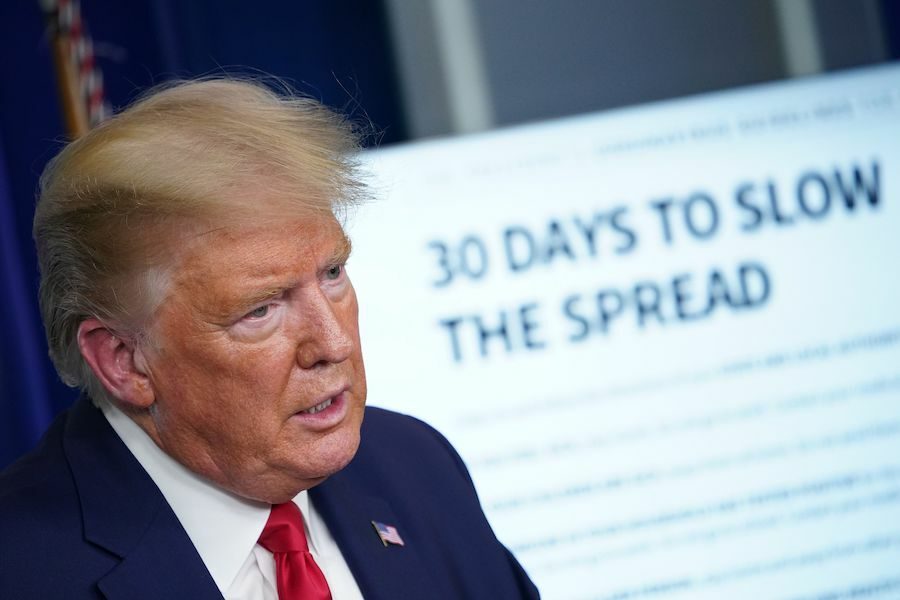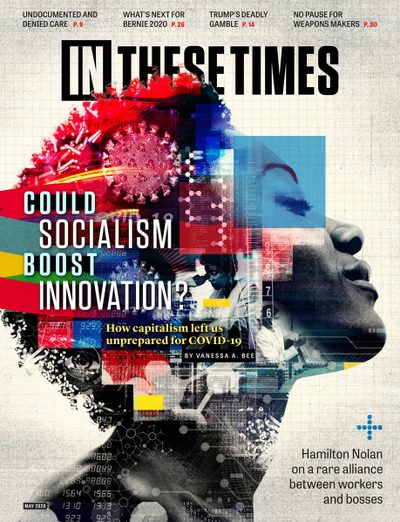This Is a Health Crisis—Stop Treating It Like a War
Even by his standards, Trump is a terrible wartime president
Joel Bleifuss

Donald Trump’s dithering and denialism in the early months of the worldwide COVID-19 pandemic will result in unimaginable numbers of dead Americans. Now, however, those are casualties of war. Parroting the talking points of his former advisor, Steve Bannon, Trump is marketing himself as the wartime president America needs. As Bannon, who now hosts the War Room: Pandemic radio show, explained: “Churchill rose to the occasion and secured his place in history. Trump’s moment is here, to grasp or to lose.”
At his March 18 COVID-19 briefing, the commander in chief updated the nation on “important developments in our war against the Chinese virus.” He spoke of an upcoming “meeting with nurses on the frontlines.” And he invoked World War II:
And now it’s our time. We must sacrifice together because we are all in this together and we’ll come through together. It’s the invisible enemy. That’s always the toughest enemy: the invisible enemy. But we’re going to defeat the invisible enemy. I think we’re going to do it even faster than we thought. And it will be a complete victory. It’ll be a total victory.
The problem? This is a public health crisis, not a war.
We are confronting a pandemic that could take the lives of untold millions. The moment requires sound science and public policies that put a premium on human life. Unfortunately, both are in short supply in the Trump White House.
But, let’s suspend disbelief and play along with Trump’s wartime conceit. If we are at war, it behooves us to ask: Which side is Trump on?
Let’s say COVID-19 is the wartime foe. Does that mean Trump is playing the part of an Axis Sally, broadcasting enemy propaganda?
Trump’s wartime strategy has been to first create an alternate reality through lies, then to lie about the lies. First, “One day it’s like a miracle — it will disappear.” Then, “I’ve always known this is a real — this is a pandemic. I felt it was a pandemic long before it was called a pandemic. I’ve always viewed it as very serious.”
Only once the bodies began stacking up did Trump began to adopt a more serious mien. But it took him weeks to move the GOP’s Grim Reaper governors like Greg Abbott in Texas, Ron DeSantis in Florida and Tate Reeves of Mississippi to take action.
In the months ahead, the death toll of this public policy failure will be there for all to see. Yet, according to Gallup, Trump’s overall approval rating has risen 5 points, to 49%, with 60% of Americans satisfied with how he is handling the crisis.
The only explanation for such widespread ignorance is that more Americans than ever are turning to the ABC, CBS and NBC nightly news. When the networks’ nightly news programs have, on average, 22 ad-free minutes to present the news, they are going to cover the daily press briefings with short, edited video clips — clips that fail to capture Trump’s daily display of lunacy and narcissism.
The problem is not lost on some in the journalism community. KUOW, Seattle’s NPR station, announced March 24 it will no longer broadcast the president’s daily briefings because it can’t fact-check the “pattern of false or misleading information” fast enough.
At In These Times, we, too, choose not to drink the Trump Kool-Aid. We have doubled down with daily coverage of the COVID-19 crisis on InTheseTimes.com, which is now read by a record number of visitors. The issue you hold in your hands includes important stories and perspectives you won’t see on the nightly news — backed with sound science and predicated on the principle that every human life matters.
Joel Bleifuss, a former director of the Peace Studies Program at the University of Missouri-Columbia, is the editor & publisher of In These Times, where he has worked since October 1986.









